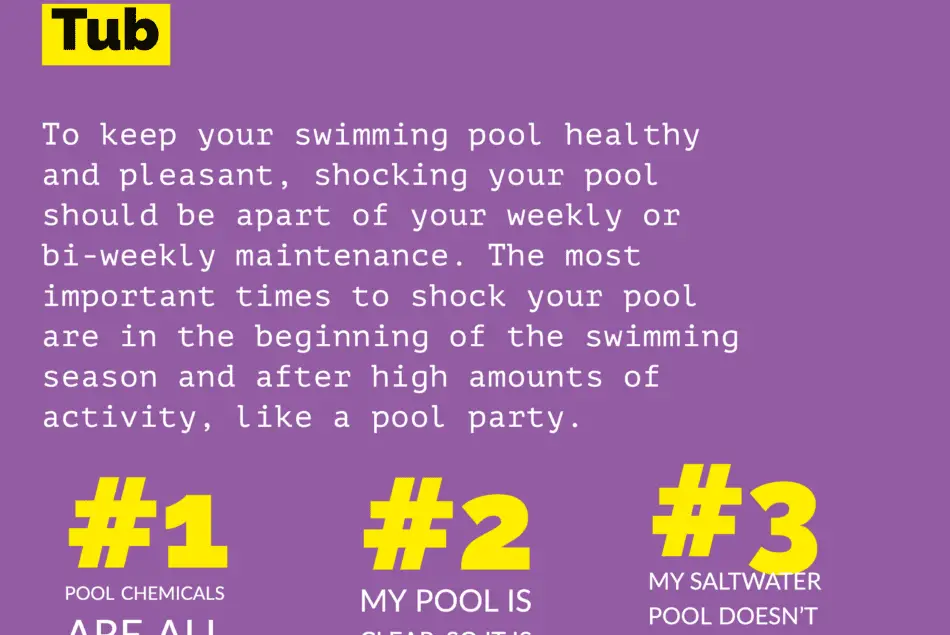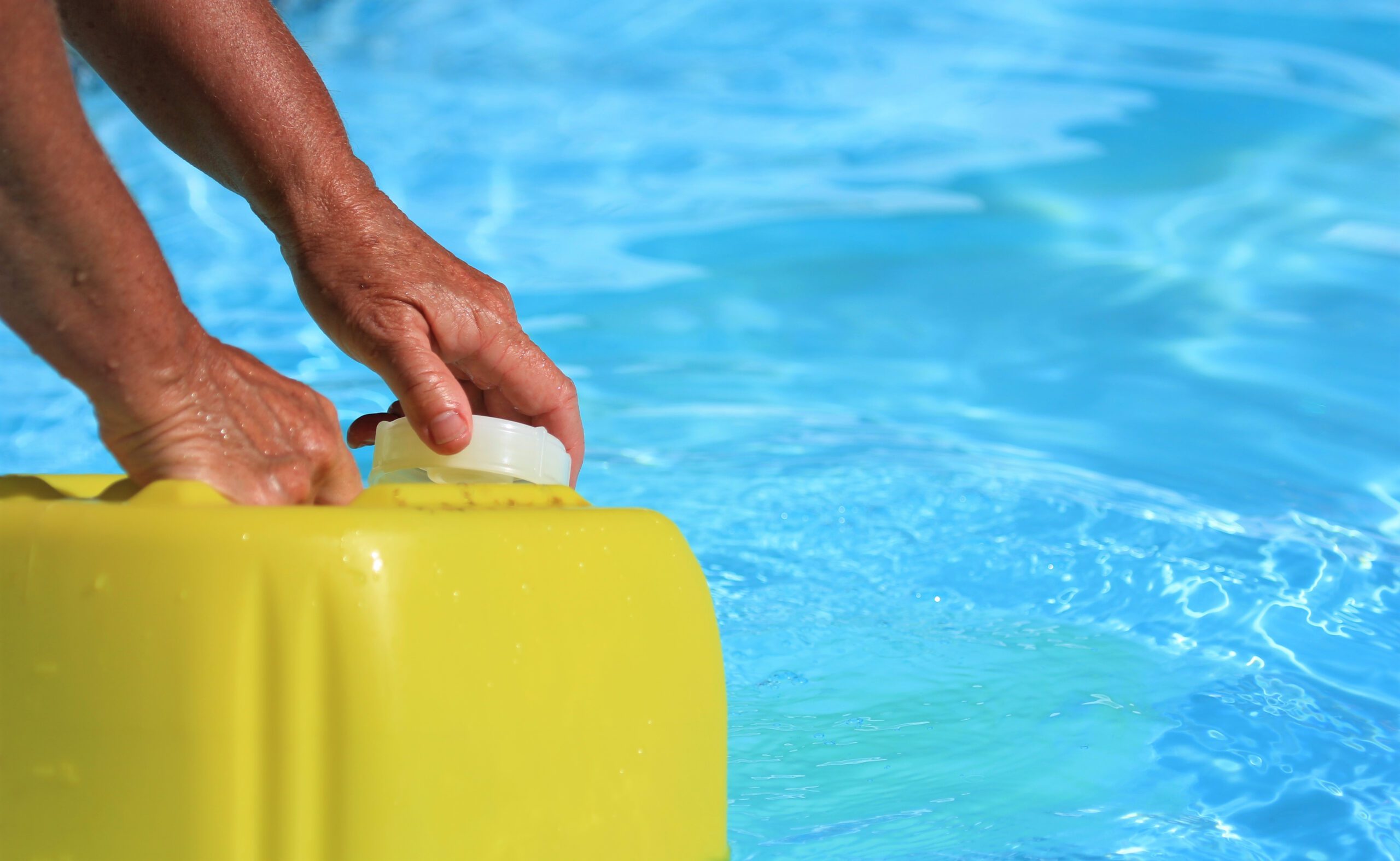
Shocking your pool should be part of your regular maintenance. It will help you avoid algae and bacteria build-up, and save you from cloudy water.
You’ve likely heard of the term “everything in moderation” at some point in your life. Surprisingly, when it comes to shocking your pool, this rule of thumb can be safely set aside. Generally speaking, the answer to “Can you over shock a pool?” is no, you cannot. You can, however, use more shock than you need – or less than is sufficient.
In other words, while you shouldn’t worry too much about adding a little extra pool shock, there is still a right way and a wrong way to shock your pool if you want to get the best results. In this quick guide, we’ll review the main factors to consider when carrying out this critical pool maintenance process.
The term “shocking your swimming pool” essentially means adding high volumes of concentrated chlorine to kill off any living contaminants (like bacteria or algae) that have developed within your pool. Although, if you overdo the shock treatment, you risk getting green hair from chlorine due to the excess chlorine oxidizing the copper in the water. You can execute a shock treatment with a few different types of pool shock, just be mindful of how much you’re using.

This is a solid form of chlorine that acts as a bleaching agent used to sanitize pool water. Calcium hypochlorite shock is most commonly found in granular form; however, it can also be found in the form of chlorine tablets.
Regardless of whether you use calcium hypochlorite in powder or tablet form, be sure to dissolve the chemical into at least five gallons of water before mixing it into the pool. This will prevent undiluted bleach from resting on the pool’s floor or liner, which can damage or stain the material.
Sodium hypochlorite (also known as liquid chlorine) is another frequently used option for shocking pool water. This is a common choice in pool shock because you can pour the solution directly into the pool without having to dissolve the chlorine in water beforehand. This type of shock is additionally beneficial in the sense that it is least likely to leave your pool cloudy, as granular shock typically does.
Lastly, another common form of granular shock is sodium dichlor. Although somewhat similar in composition to calcium hypochlorite, the main difference is that sodium dichlor also contains cyanuric acid (CYA). In pool water, CYA keeps chlorine intact for longer and prevents it from degrading in the sunlight.
By using a test kit to check your water and assess your CYA level, you can determine whether you want this additional CYA included in your pool shock. If you are low on CYA, sodium dichlor may be perfect for restoring order to your pool’s chemistry. And again, since sodium dichlor is a solid, granular shock, be sure to dissolve it in water before introducing it to your pool.
A simple ratio and a standard rule of thumb to follow when you shock your pool is to dissolve one pound of either calcium hypochlorite or sodium dichlor for every 10,000 gallons of pool water. If you are using sodium hypochlorite, i.e., liquid chlorine, the ratio comes out to 10 ounces for every 10,000 gallons of pool water.
If you are not sure how many gallons are in your pool, here is an easy formula:
Length of your pool (ft.) x width (ft.) x depth (ft.) x 7.5 = volume in gallons
You can also use the Pool Volume Calculator that is built into the Pool Calculator App, available as a desktop app, or as a Native App on iOS or Android
Another standard measurement point for shocking a pool is to measure the chlorine by parts per million (PPM). To successfully shock a pool, especially one with algae growth, you’ll need to bring the chlorine level to at least 30ppm.
Adding a ton of shock to your pool just for the heck of it won’t speed up the cleaning process. If it’s your first time shocking a pool, and you see unexpected cloudiness, don’t panic and start aggressively dumping shock into your pool. Some cloudiness is normal and to be expected. In order to clear out a cloudy pool after shocking, you will need to keep your pump and filter on with the circulation continually running. This will likely take 4-6 hours.
Even though it should only take 4-6 hours to clear the cloudiness, you shouldn’t measure your chlorine levels the same day you’ve shocked the pool. High chlorine levels will bleach your test strip and give you a false reading. This false reading may convince you that your pool doesn’t have enough shock when, in reality, it does. You want to avoid adding excess chlorine, so it’s best to wait a few days before testing the water. The best thing you can do if you put too much shock in your pool is to wait it out. Pro tip: the more sunlight your pool water gets, the faster the shock will dissipate.
But you’re also probably wondering, “Why is my pool green?” or “Why exactly does this cloudiness occur?”. It’s important to note that shocking alone does not clear up a green or cloudy pool. To get crystal clear water, you also need to have a good filter. The amount of shock you put in the pool doesn’t matter if you have a bad filter. The green coloration and the cloudiness have to do with the chemical composition of your pool – specifically calcium hardness, pH, and CYA concentration. When you shock the pool, you are adjusting each of these levels, depending on which type of shock you choose. Let’s explore each of these three factors:
Knowing your pool’s calcium hardness level can help you select the type of shock best suited for its chemical composition, and ultimately avoid cloudy water. If you already have high calcium hardness levels in your pool, you will want to avoid calcium hypochlorite as a shock treatment. The additional calcium in calcium hypochlorite adds to your pool’s calcium hardness levels – and when there is an excessive amount of calcium in the pool, you will begin to see cloudy water. Instead, opt for a sodium dichlor or sodium hypochlorite shock treatment to avoid excessive calcium hardness levels.
When you shock a pool, you test and adjust the pH level for a reason. With that said, if you shock a pool outside of the 7.2 to 7.4 pH range, not only will you waste a significant amount of the chlorine used, you will also end up with cloudy water.
Lastly, cyanuric acid levels are also important to assess when shocking your pool. As previously mentioned, if your pool’s chemical balance has low levels of CYA, it is ideal to use a sodium dichlor shock to bring those levels back up. However, too much CYA can also lead to this cloudiness after the shock treatment.

Shocking your pool should be part of your regular maintenance. It will help you avoid algae and bacteria build-up, and save you from cloudy water.
Now that you’ve selected the right shock for your pool and calculated how much you need, it’s time to shock your pool! Here are three important steps to follow:
It’s essential to test your pool’s pH level, as raising the alkalinity is exactly what makes the shock effective. A simple way to monitor your pool’s pH – and myriad other chemical levels, including chemical hardness and CYA – is with the handy Pool Calculator app, available on both iOS and Android devices.
The most optimal and effective pH level to shock a pool is anywhere between 7.2 and 7.4. If the pool water is anywhere outside of this range, the water will not be suitable for the shock, making the treatment significantly less effective.
Once you have tested the water, you can adjust the pH level accordingly. If the pH level is below 7.2, you will need to raise it by adding baking soda. On the other hand, if your pH level is too high, you can use muriatic acid to drop the pH to between 7.2 and 7.4.
Waiting until after sunset is another way to ensure the effectiveness of shocking your pool. If you attempt to shock your pool during the day, UV rays from the sunlight will degrade the free chlorine, making the treatment far less potent and useful. Further, shocking the pool at night is also beneficial because the treatment will have plenty of time to get the job done. This means that once the pool has been shocked overnight, it should be ready to swim in the following day after a few hours of filtering to disperse any lingering cloudiness.
During the shock treatment, and especially after, it is important to keep your pump and filter on and running. This will ensure that the added chlorine is evenly distributed throughout the entire pool to get rid of bacteria and algae in the pool water. Once the shock treatment has been completed, keep the pump and filter running for a few hours to circulate the water. This will clean up the remnants of the shock and disperse any remaining cloudiness.
While you may not be too worried about over shocking your pool now, each element of the shock treatment is important. It’s critical to get the process right, so you can achieve quick results and get back to swimming. Learning the ins and outs of how to shock a pool will help you better maintain your pool moving forward.
For more tips and tricks on how to maintain your pool or hot tub, check out our blog! We have the tools you need to keep your pool in pristine condition all year round.

In this detailed guide, we’ll help you find the best pool shock, so you can keep your chlorine or saltwater pool clean, clear, and healthy for swimming.
Sources:
https://dengarden.com/swimming-pools/Cloudy-Swimming-Pool-Water
https://www.medallionenergy.com/blog/9-mistakes-pool-owners-make
https://dengarden.com/swimming-pools/Shocking-a-Non-Saltwater-Swimming-Pool

Want to learn more about algaecide? Read on to find out when to add algaecide to your pool maintenance routine and other helpful tips.

In this quick guide, we’ll answer the question “can you over shock a pool” and unveil the factors to consider when shocking a pool.

Maintaining both pH and total alkalinity in your swimming pool is important for keeping your pool properly sanitized and non-corrosive. Total alkalinity is to pH what cyanuric acid is to free chlorine. Total alkalinity stabilizes pH levels. The ideal pool pH level is 7.4 to 7.6. The ideal total alkalinity level is 80 to 120 ppm.

The Association of Pool and Spa Professionals recommends free chlorine levels for both swimming pools and hot tubs be kept between 2.0 and 4.0 ppm. However, the Center for Disease Control recommends free chlorine stay above 1 ppm in pools and 3 ppm in hot tubs.